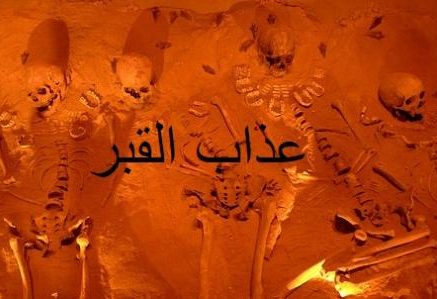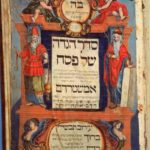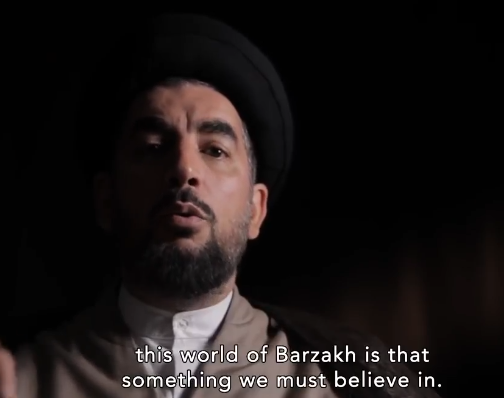
The ‘torment of the grave’ is one of the superstitions that Rabbi Ka‘b ibn Māti‘ and his associates such as Wahb ibn Munabbih, ‘Abdullah ibn Salām and Ibn Jurayj succeeded in introducing into Islamic belief by exploiting the cultural gap between them and those who lived in the era of early Islam, people such as Abū Hurayra who admitted that he was not good at writing or reading.
HOWEVER, IT WAS FROM THIS same Abū Hurayra that the largest volume of hadiths falsely attributed to the Prophet were taken. These turned out to be mainly from Rabbi Ka‘b ibn Māti‘ and his group and the enthusiasms of some who were still children when the Prophet died, people such as Ibn ‘Abbās, whose aspiration to appear as a Muslim scholar was exploited. These superstitions leaked into Islamic doctrines to become part of the faith’s fundamentals, despite the fact that they were not present in any of the books of the Abrahamic religions Islam, Christianity and Judaism.
In fact the Qur’ānic verses deny the existence of any torment before the Day of Resurrection, as we can see in Sūrat Al-Sāffāt verses 58-59:
Are we then not to die, saving our former death, and are we not to be punished?
This proves the invalidity of any torment of the grave, and is even confirmed by Sūrat Āl ‘Imrān verse 185:
Every soul will taste of death. And ye will be paid on the Day of Resurrection.
One should therefore first emphasize that the torment of the grave is not explicitly mentioned either in the Qur’an, the Bible or the Torah. Indeed the Qur’ān makes no mention of any period of existence life between the death of a person and his resurrection on the Day of Resurrection. All that is mentioned in this regard refers to the Barzakh,[1] the barrier that separates the life on earth from the live in the Hereafter, and any sense of a time or place beyond this barrier is non-existent.
Ibn Qayyim al-Jawziyya records that
Abu Muhammad ibn Ḥazm said in the book Al-Milal wal-Niḥal ‘As for those who think that the deceased will live on in his grave before the Day of Resurrection, this is wrong. The verses that we have mentioned deny that, verses such as the Almighty’s words: They say: Our Lord! Twice hast Thou made us die, and twice hast Thou made us live.[2] The Almighty also says: How disbelieve ye in Allah when ye were dead and He gave life to you! Then He will give you death, then life again?[3] If the deceased lives on in his grave the Almighty would have made us to die three times and revive three times, and this is invalid and contrary to the Qur’ān. Those whom God brought back to life were granted this as a sign to one of the prophets, such as those who went forth from their habitations in their thousands, fearing death, and Allah said unto them: Die; and then He brought them back to life,[4] or those who passed by a town, and it had fallen down upon its roofs[5] as was specific to them. There is also the Almighty’s saying: Allah takes the souls at the time of their death, and those that die not during their sleep; then He withholds those on whom He has passed the decree of death and sends the others back till an appointed term.[6] It is clear in the Qur’ānic text that the souls of others than those we have mentioned above do not return to their bodies until the appointed time, and this is the Day of Resurrection.
The hadiths that are falsely attributed to the Prophet acknowledge that those who told the Muslims and the Prophet about the punishment of the grave were the Jews in Madīna. This is how it was narrated in the two Ṣaḥīḥ collections of hadith, those of al-Bukhārī and Muslim. This belief is identical to the Zoroastrian belief widespread in Babylon and also found among the ancient Egyptians and Greeks. It is a generic religious vision found all over the ancient East. What was worshipped in Egypt had its counterpart in Phoenicia and Babylon. Even the beliefs of the ancient Greeks were not free of this concept. Their belief in accountability and punishment being something taking place in the grave accounts for why they buried the deceased’s possessions along with him.
For the Jews the belief in the Day of Resurrection came late, specifically after the writing of both parts of the Talmud the Mishnah and the Gemara. The Talmud was written down approximately seven centuries after the books of the Torah. This means that the Jews lived for centuries believing that the tomb was the final fate of the deceased, and that the eschatological reckoning took place there. In this sense, the ‘torment of the grave’ finds no mention in the Torah, nor in the Mishna or the Talmud.
This belief is identical to the Zoroastrian belief widespread in Babylon and also found among the ancient Egyptians and Greeks
But we do find it mentioned in the Kabbalah texts titled The Plagues of the Grave where the Angel of Death asks the deceased: “What is your name?” If the deceased has been good, he remembers his own name and answers, and the Angel of Death turns away. But if he has been bad he will forgets his own name, and the Angel of Death will beat him severely, cut off his four limbs, and then depart. Then his minions will come soon after and give him back those limbs that the Angel of Death had cut off!
This is to prepare him for a new round of the same from the Angel of Death, and this cycle of torment and beatings will be repeated commensurate to the deeds of the deceased. It is worth noting that in Judaism there is a prayer performed by worshippers which includes a charm against forgetting one’s name after death to guard against this! Moreover, if the relatives of the deceased want to raise the chances for their deceased to avoid the torment of the grave, they recite some remembrances specially selected so that their paragraphs begin with the first letters of the name of the deceased, which it is said will protect him from the torment of the grave.

Suggested Reading
Professor Firās Al-Sawwāḥ[7] notes that
“The biblical view of life after death was no different from what prevailed in both the Eastern and Classical Greco-Roman religious systems. The soul of the deceased stays for three days next to his body in the tomb, then descends from it to a lower chasm called in the Torah Sheol (or the ‘Abyss’ according to Arabic translations), which equates to the Mesopotamian Kur or the Greco-Roman Hades. There it remains in some ghostly state devoid of warmth or food. As Isaiah put it, the dead lie down together, they shall not rise, they are extinct, they are quenched as a wick.[8] The book of Jeremiah describes how they sleep a perpetual sleep, and not wake.[9]
This sleep, from which there is no awakening, is most eloquently described in this passage from the book of Job:
For there is hope for a tree if it be cut down, that it will sprout again, and that the tender branch thereof will not cease. Though the root thereof wax old in the earth, and the stock thereof die in the ground; Yet through the scent of water it will bud, and put forth boughs like a plant. But man dieth, and lieth low; yea, man perisheth, and where is he? As the waters fail from the sea, and the river is drained dry; So man lieth down and riseth not.[10]
Professor Firās Al-Sawwāḥ adds:
The Prophet Samuel, one of the greatest prophets of the Torah, descends after his death into the abyss. King Saul invoked his spirit from the underworld through a spiritual medium in order to consult him. Samuel thus ascended from the world of the dead in the form of an old man covered with a veil. Then Saul bowed with his face to the ground and prostrated himself. And Samuel said to Saul: ‘Why hast thou disquieted me, to bring me up?’ And Saul answered: ‘I am sore distressed [11]
For their part, none of the remaining religious parties in Palestine believed in the resurrection of the dead, and the tomb was for them merely a passageway to the underworld of dreams and lowly shadows, much like the rest of the Syrian forms of worship. But the cultural exchange that took place with Persia during the Persian overlordship of the Levant between 539 BC and 332 BC led to the spread of some Zoroastrian religious ideas in the region, the most important of which was the idea of the Saviour of mankind, one who will appear at the end of times, and the idea of a general resurrection of the dead and the return of the soul to the body for the final reckoning.
Some Jews clung on to the old Biblical line of thinking (the non-resurrection of the dead) even into relatively late times, that is, to the first century AD, and Professor Firās Al-Sawwāḥ describes the eschatological beliefs of some Jewish parties or sects, and how these new Zoroastrian concepts became “progressively rooted into one of the main Jewish sects in the first century AD – the Pharisees – who believed in the physical resurrection of the dead on the Last Day of the Lord.”
[1] This is the intermediate state in which the soul of the deceased is transferred across the boundaries of the mortal realm to a state where the soul will rest until the Day of Judgement. The term appears in Qur’ān XXIII, 100: and behind them is a partition until the day when they are raised. The origin of the word is the Middle Persian term Barzag, denoting a barrier or partition. While modern scholars downplay the existence of this state, for Al-Ghazālī it was a very real phenomenon: “After the First Blast, all created beings shall abide for forty (it is unknown if it is a year or month or etc.) in the Intermediate Realm barzakh. Then shall God quicken Seraphiel, and command him to deliver the Second Blast, as He has said (Exalted is He!): Then shall it be blown again, and lo! they stand, beholding : they shall be on their feet, watching the Resurrection” (Ed.)
[2] Qur’ān XL (al-Ghāfir), 11.
[3] Qur’ān II (al-Baqara), 28.
[4] Qur’ān II (al-Baqara), 243.
[5] Qur’ān II (al-Baqara), 259.
[6] Qur’ān XXXIX (al-Zumar), 42.
[7] Firās Al-Sawwāḥ, ألغاز الأناجيل (‘Mysteries of the Gospels’) – Dar Al-Takwīn Publications, Damascus 2012, Section: ‘The Resurrection of Jesus’, page 326.
[8] Isaiah, XLIII, 17: יַחְדָּו יִשְׁכְּבוּ בַּל-יָקוּמוּ, דָּעֲכוּ כַּפִּשְׁתָּה כָבוּ
[9] Jeremiah, LI, 39: וְיָשְׁנוּ שְׁנַת-עוֹלָם, וְלֹא יָקִיצוּ
[10] Job, XIV, 7-12.
[11] I Samuel, 28.

